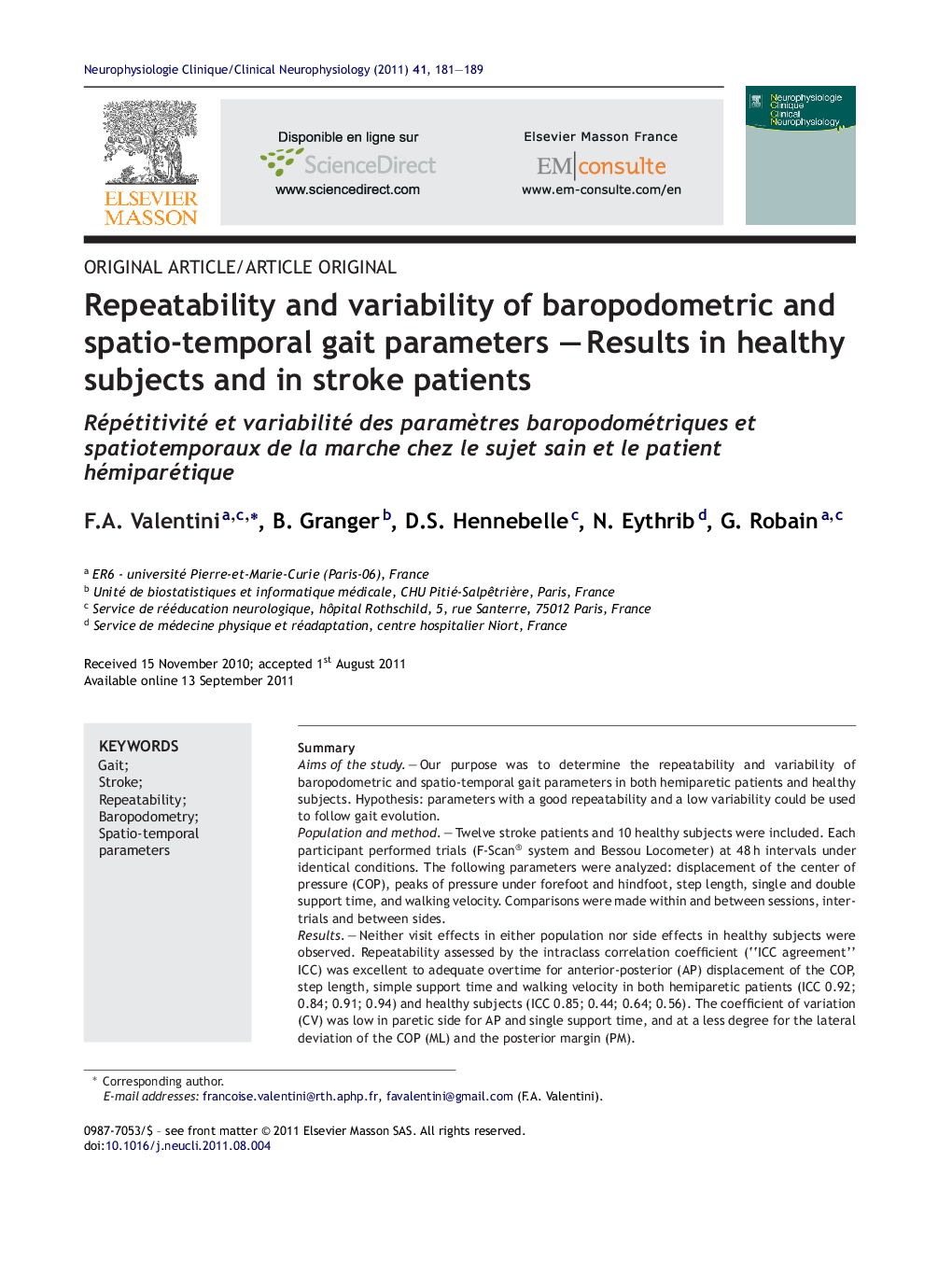| Article ID | Journal | Published Year | Pages | File Type |
|---|---|---|---|---|
| 3082946 | Neurophysiologie Clinique/Clinical Neurophysiology | 2011 | 9 Pages |
SummaryAims of the studyOur purpose was to determine the repeatability and variability of baropodometric and spatio-temporal gait parameters in both hemiparetic patients and healthy subjects. Hypothesis: parameters with a good repeatability and a low variability could be used to follow gait evolution.Population and methodTwelve stroke patients and 10 healthy subjects were included. Each participant performed trials (F-Scan® system and Bessou Locometer) at 48 h intervals under identical conditions. The following parameters were analyzed: displacement of the center of pressure (COP), peaks of pressure under forefoot and hindfoot, step length, single and double support time, and walking velocity. Comparisons were made within and between sessions, inter-trials and between sides.ResultsNeither visit effects in either population nor side effects in healthy subjects were observed. Repeatability assessed by the intraclass correlation coefficient (“ICC agreement” ICC) was excellent to adequate overtime for anterior-posterior (AP) displacement of the COP, step length, simple support time and walking velocity in both hemiparetic patients (ICC 0.92; 0.84; 0.91; 0.94) and healthy subjects (ICC 0.85; 0.44; 0.64; 0.56). The coefficient of variation (CV) was low in paretic side for AP and single support time, and at a less degree for the lateral deviation of the COP (ML) and the posterior margin (PM).ConclusionIn this study, baropodometric (AP and PM) and spatio-temporal gait (step length, single support time and walking velocity) parameters were found to show good repeatability overtime; these parameters are the ones most likely to be useful in assessing the effects of treatments that are proposed to improve gait in stroke patients.
RésuméBut de l’étudeÉvaluer la répétabilité et la variabilité des paramètres baropodométriques et spatiotemporels de la marche chez des patients hémiparétiques et des sujets sains. Hypothèse : les paramètres ayant une bonne répétabilité et une faible variabilité pourraient être utilisés pour suivre les modifications de la marche dans le temps.Population et méthodesDouze patients hémiparétiques et dix volontaires sains ont été inclus, chacun réalisant des tests (F-Scan® système et Locomètre de Bessou) à 48 heures d’intervalle dans des conditions identiques. Le déplacement du centre de pression (COP), les pics de pression sous l’avant-pied et l’arrière-pied, la longueur du pas, les durées de simple et double appui et la vitesse de marche ont été analysés. Les comparaisons étaient effectuées inter-sessions, inter-essais et inter-côtés.RésultatsAucun effet visite ou effet côté chez les sujets sains. La répétabilité, évaluée par le coefficient de corrélation intraclasse (« ICC agreement » ICC) était excellente dans le temps pour le déplacement antéropostérieur (AP) du COP, la longueur du pas, la durée du simple appui et la vitesse de marche chez les patients hémiparétiques (ICC 0,92 ; 0,84 ; 0,91 ; 0,94) et excellente ou adéquate chez les sujets sains (ICC 0,85 ; 0,44 ; 0,64 ; 0,56). Le coefficient de variation (CV) était faible du côté parétique pour l’AP et la durée du simple appui et à un degré moindre pour la déviation latérale du COP (ML) et la marge postérieure (PM).ConclusionsDans cette étude, des paramètres baropodométriques (AP et PM du COP) et spatiotemporels (longueur du pas, durée de simple appui et vitesse) de la marche ont été identifiés comme ayant une bonne répétabilité dans le temps ; ils pourraient être utilisés pour évaluer les effets des traitements proposés pour améliorer la marche du patient hémiparétique.
